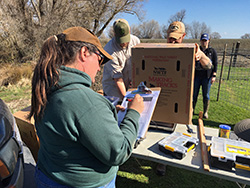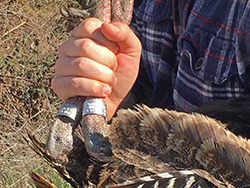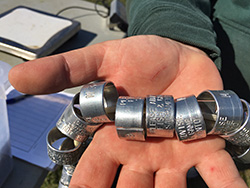Scientists at the California Department of Fish and Wildlife and volunteers from the National Wild Turkey Federation conduct annual spring trapping and banding of wild turkeys at the Upper Butte Basin Wildlife Area in order to better understand the characteristics, habitat preferences and the dynamics of the growing population of wild turkeys using the wildlife area and surrounding properties.

Environmental Scientist Laura Cockrell records the weight of a wild turkey at Little Dry Creek prior to banding.

Wild turkeys banded in 2019 and 2020 are given one traditional, butt-end band on one leg and one rivet band on the other.

Environmental Scientist Laura Cockrell shows off the supply of butt-end bands prior to banding.
Turkey hunters in parts of Butte and Glenn counties who are skilled and lucky enough to bag a tom this spring may be in for a pleasant surprise: Their bird may be sporting some jewelry – a band on each leg.
Since early February, CDFW biologists at the Upper Butte Basin Wildlife Area – supported by the National Wild Turkey Federation (NWTF) – have been busy trapping and double-banding wild turkeys at the wildlife area’s Howard Slough and Little Dry Creek units. So far this year, some 45 turkeys have been banded, which include toms, hens and young males known as “jakes.”
The staff and volunteers have just about a month and a half to trap and band all the wild turkeys they can between the close of the waterfowl hunting season and the start of the spring wild turkey season in mid-March. It’s part of an innovative research effort aimed at better understanding the characteristics, growth rates, habitat use, range and abundance of the growing population of wild turkeys using the wildlife area.
Bird bands long have been an important research tool for biologists and considered a prize among many hunters who are allowed to keep them after reporting the band information. The Upper Butte Basin turkey banding project is the only one of its kind in the state, making those turkey bands a rare commodity and a valuable potential data source.
In addition to the banding, the turkeys are weighed, sexed and measured at various points before being released.
The wild turkey study began at the wildlife area in 2015 along with the launch of limited spring wild turkey hunts there. NWTF helped secure grant funding to start the hunt program and initiate the research effort. The funds came from the sale of upland game bird hunting validations and stamps required of upland game bird hunters.
“We thought it would be great to start getting an abundance estimate for the turkeys that we do have out here to make sure that we weren’t harming the population through the hunt program and also to see how much hunter opportunity we could potentially utilize,” said Kevin Vella, NWTF’s district biologist for California, Nevada, Oregon and Washington.
The spring wild turkey hunt program has been so successful and popular over its short history funding for the program and its research component will continue under CDFW’s general budget moving forward.
“I think Howard Slough especially offers some of the best turkey hunting I’ve seen anywhere,” said Upper Butte Basin Wildlife Area Manager Tim Hermansen. “Certainly, youth hunters have an excellent opportunity out here.”
Spring turkey hunts at both the Howard Slough and Little Dry Creek units are limited to lottery drawings through CDFW’s website in order to ensure an uncrowded, high-quality hunting experience. The hunter quota and the turkey harvest both have grown over the years along with the local turkey population. Hunter success ranged from 30 to 60 percent during the 2019 spring season but reached 100 percent for the youth hunt at Howard Slough in 2018.
Back to those double-banded birds.
Although 101 turkeys were banded at the wildlife area between 2015 and 2019, only three banded turkeys have been reported by hunters. That leads biologists to believe most of the turkeys have been prying off the traditional, “butt-end” bird bands, which have two edges that butt evenly together when clamped on.
The NWTF has since supplied Upper Butte Basin with rivet bands that are made of a harder metal and riveted closed when attached. The turkeys banded in 2019 and 2020 now receive a butt-end bird band on one leg and a rivet band on the other. Any of those harvested birds wearing a single rivet band will confirm suspicions that the birds have been prying off the butt-end bands.
“That’s the downside of doing any kind of novel research,” explained Laura Cockrell, a CDFW environmental scientist based at the Upper Butte Basin. “You only have your own mistakes to learn from.”
CDFW Photos. Top Photo: Upper Butte Basin Wildlife Area Manager Tim Hermansen releases a wild turkey after banding as Fish and Wildlife Technician Derek Schiewek and Seasonal Aid John Davis look on.
Media Contact:
Peter Tira, CDFW Communications, (916) 322-8908